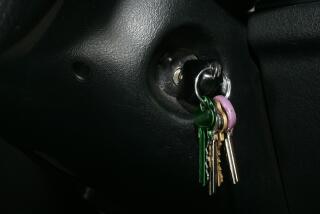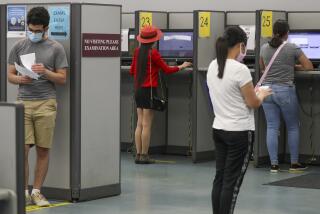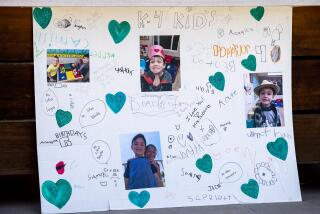Front-seat rider to the rescue
If you are the type to worry about a meteor crashing through your windshield, here’s a more realistic problem: drivers who lose consiousness in a moving car.
A letter from a reader asked what a passenger can do when the driver becomes incapacitated.
“If a person is a passenger in the front seat and the driver all of a sudden has a heart attack or stroke, how can the passenger stop the car?” asked Judy Hoffmann of Westlake Village. “There’s that big console between the seats. It would be impossible to get a leg over to hit the brake.”
Hoffmann said she hasn’t seen anything in manuals or the California Department of Motor Vehicles’ drivers handbook on this issue.
Indeed, it is a potential problem that is quickly dismissed, based on my conversations with state officials -- one of whom compared the situation to a meteor crashing through a windshield or a gas tank spontaneously exploding.
I asked a representative of the National Highway Traffic Safety Administration whether its researchers had looked into the issue and found that the agency had some data showing the scope of the problem.
In 2005, there were 521 fatal crashes in which illness was a factor in one of the drivers, according to the agency’s fatality analysis reporting system.
The crashes killed 422 of the ill drivers, 65 occupants of the ill drivers’ vehicles, 61 occupants of other vehicles and 15 pedestrians or bicyclists. A total of 563 people were killed, more than 1% of the total highway deaths that year.
The medical conditions included seizures, heart attacks and fainting, among other problems, said Rae Tyson, an agency spokesman.
The problem is obviously not as far-reaching as speeding or drunk driving and the fatalities that result, but it’s not something to be dismissed as irrelevant.
Any time you have a driving issue that kills hundreds of people annually, it’s worth attention. Other examples of such crash categories are fog and mechanical defects.
What the statistics don’t tell us is how many other accidents were prevented by passengers taking control of the vehicle, an action that is not recorded in national databases.
The prospect of a passenger climbing over a console and grabbing a steering wheel seems like something out of a Hollywood script, good drama but almost impossible to execute. But I was surprised to immediately run across some examples.
When I suggested this story, my editor told me that his 20-year-old son had to take control of a vehicle on the Long Beach Freeway last year after the friend who was driving lost consciousness due to a seizure.
The driver’s foot had jammed the accelerator to the floor, taking the car to more than 90 miles per hour. With care, the young man pulled his friend’s foot off the pedal, steered the car to the shoulder and managed to slow the vehicle to a stop. With that kind of quick thinking and cool reaction, he should qualify for some kind of national award for good driving.
A related issue is the presumption that adult drivers may have a responsibility to take control of a vehicle driven by a teen with a learner’s permit.
A publication issued by the state DMV titled “Parent and Teen Guide” advises parents to sit close enough to their teens so that they can grab the steering wheel, if necessary. But that’s about the only reference the DMV makes to the issue.
The agency, however, does not make any clear recommendations on what emergency procedures to follow, according to agency spokesman Steve Haskins.
“We don’t recommend anything,” Haskins said.
“Those situations are all going to be different. You can’t surmise conditions in every situation. If we did recommend something and there was a death, we could be liable,” he said.
Haskins is right that you can’t provide a standard emergency procedure that would apply to every situation, but the DMV could be doing a lot more to deal with the issue, particularly about informing parents of their responsibilities as supervising adult drivers.
As far as helping when a driver loses consciousness, Sgt. Mark Garrett of the California Highway Patrol said that it is a freak circumstance but that passengers need to be cool about what they do.
One piece of advice is to not turn off the engine, since that will also disable the power steering and power brakes, making it more difficult to control the vehicle.
Center consoles make the job particularly difficult, along with seat belts. A passenger would have to make the tough choice of releasing his or her belt to reach the brake pedal, risking greater injury in a crash but possibly lowering the risk of the crash itself.
In most cases, the passenger should be able to reach the steering wheel and at least pull the driver’s leg off the accelerator without unbelting.
More to Read
Sign up for Essential California
The most important California stories and recommendations in your inbox every morning.
You may occasionally receive promotional content from the Los Angeles Times.











